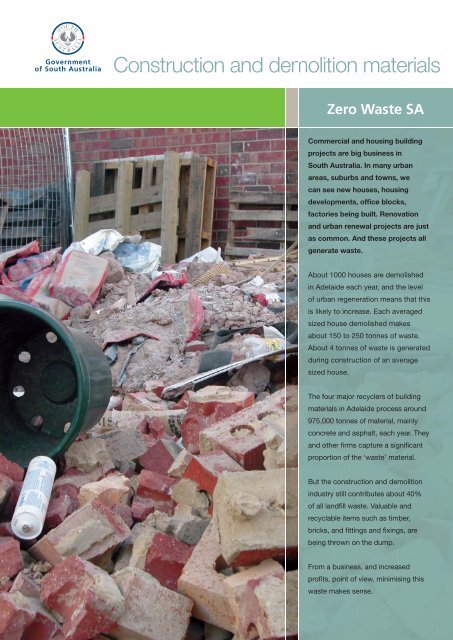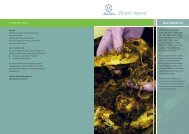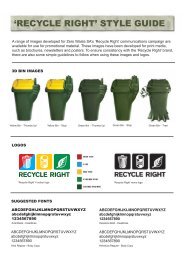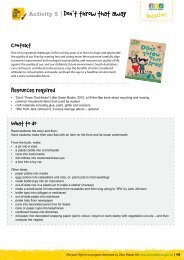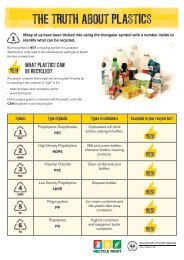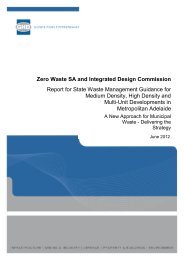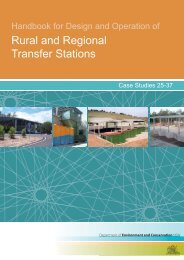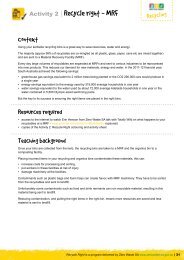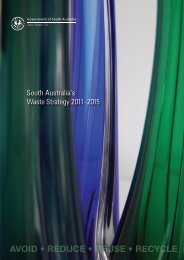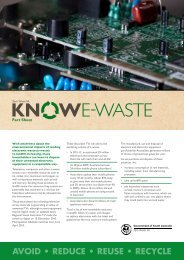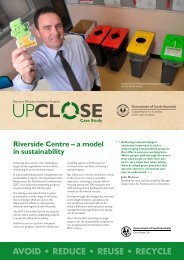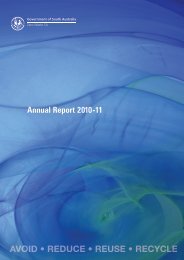Download as pdf - Zero Waste SA - SA.Gov.au
Download as pdf - Zero Waste SA - SA.Gov.au
Download as pdf - Zero Waste SA - SA.Gov.au
You also want an ePaper? Increase the reach of your titles
YUMPU automatically turns print PDFs into web optimized ePapers that Google loves.
Construction and demolition materials<br />
<strong>Zero</strong> W<strong>as</strong>te <strong>SA</strong><br />
Commercial and housing building<br />
projects are big business in<br />
South Australia. In many urban<br />
are<strong>as</strong>, suburbs and towns, we<br />
can see new houses, housing<br />
developments, office blocks,<br />
factories being built. Renovation<br />
and urban renewal projects are just<br />
<strong>as</strong> common. And these projects all<br />
generate w<strong>as</strong>te.<br />
About 1000 houses are demolished<br />
in Adelaide each year, and the level<br />
of urban regeneration means that this<br />
is likely to incre<strong>as</strong>e. Each averaged<br />
sized house demolished makes<br />
about 150 to 250 tonnes of w<strong>as</strong>te.<br />
About 4 tonnes of w<strong>as</strong>te is generated<br />
during construction of an average<br />
sized house.<br />
The four major recyclers of building<br />
materials in Adelaide process around<br />
975,000 tonnes of material, mainly<br />
concrete and <strong>as</strong>phalt, each year. They<br />
and other firms capture a significant<br />
proportion of the ‘w<strong>as</strong>te’ material.<br />
But the construction and demolition<br />
industry still contributes about 40%<br />
of all landfill w<strong>as</strong>te. Valuable and<br />
recyclable items such <strong>as</strong> timber,<br />
bricks, and fittings and fixings, are<br />
being thrown on the dump.<br />
From a business, and incre<strong>as</strong>ed<br />
profits, point of view, minimising this<br />
w<strong>as</strong>te makes sense.
Everyone involved in the industry can make a difference<br />
in managing building and construction w<strong>as</strong>te:<br />
■<br />
■<br />
■<br />
■<br />
■<br />
■<br />
■<br />
■<br />
clients<br />
householders<br />
business<br />
government<br />
architects or designers<br />
builders<br />
project managers<br />
contractors.<br />
What can we do?<br />
We can all minimise construction w<strong>as</strong>te by following<br />
the 3Rs - reduce, reuse, recycle.<br />
MATERIAL<br />
M<strong>as</strong>onry, concrete,<br />
construction aggregate<br />
Bricks, tiles<br />
Timber<br />
Gl<strong>as</strong>s<br />
Insulation material<br />
Metals<br />
Trees, organic material<br />
REUSE AND RECYCLING<br />
Pavements, roads, carparks,<br />
driveways, shoulder aggregate,<br />
pipe bedding, erosion control,<br />
landscaping<br />
Salvaged and resold<br />
Floorboards, reconstituted<br />
panelboards, doors, furniture,<br />
fencing, mulch<br />
Crushed for compaction fill<br />
Housing insulation<br />
Remelted into secondary<br />
materials for structural steel,<br />
roofing, piping etc<br />
Compost<br />
Reduce<br />
Builders can reduce w<strong>as</strong>te by:<br />
■<br />
■<br />
■<br />
■<br />
using standard size and prefabricated building<br />
materials for timber, pl<strong>as</strong>terboard and bricks to<br />
reduce w<strong>as</strong>te from offcuts and costs for handling<br />
and disposal<br />
preparing a w<strong>as</strong>te minimisation plan <strong>as</strong> part of<br />
their contract (and reporting back)<br />
using secondhand or recycled materials<br />
salvaging <strong>as</strong> much material <strong>as</strong> possible from the<br />
demolished structure for the new one.<br />
Reuse<br />
Unwanted building materials, fixtures and fittings, and<br />
heritage items such <strong>as</strong> old fireplaces and windows can<br />
be sold at specialist or general secondhand or salvage<br />
outlets.<br />
Recycle<br />
Recycling w<strong>as</strong>te can generate substantial savings in<br />
building and construction.<br />
In South Australia:<br />
■<br />
■<br />
residents can put out material for pick up in<br />
kerbside hard w<strong>as</strong>te collection schemes run by<br />
local councils (check with your council whether<br />
they provide this service and about the type and<br />
amount of material that can be collected)<br />
building contractors can separate w<strong>as</strong>te streams<br />
at the construction site and take construction and<br />
demolition w<strong>as</strong>te to recycling firms in preference<br />
to landfill.<br />
Pl<strong>as</strong>tics<br />
Paper, cardboard<br />
Fittings (baths, toilets, sinks)<br />
Use <strong>Zero</strong> W<strong>as</strong>te’s Recycling Information Directory<br />
www.zerow<strong>as</strong>te.sa.gov.<strong>au</strong>/rid.php to find information<br />
about recycling services in your area.<br />
Further information<br />
www.ecorecycle.vic.gov.<strong>au</strong> h<strong>as</strong> links to information<br />
for developers, architects, designers, builders and<br />
local government on w<strong>as</strong>te minimisation strategies,<br />
contracts and recycling guides for the industry. It also<br />
h<strong>as</strong> useful information on w<strong>as</strong>te minimisation plans.<br />
<strong>Zero</strong> W<strong>as</strong>te <strong>SA</strong><br />
The goal of <strong>Zero</strong> W<strong>as</strong>te <strong>SA</strong> is to eliminate w<strong>as</strong>te or its<br />
disposal in landfill by encouraging South Australians to:<br />
■<br />
■<br />
■<br />
reduce their consumption of resources<br />
reuse and recycle materials.<br />
Visit <strong>Zero</strong> W<strong>as</strong>te <strong>SA</strong>’s website at<br />
www.zerow<strong>as</strong>te.sa.gov.<strong>au</strong><br />
Secondary materials for<br />
playgrounds, park benches etc<br />
Mulch, compost, animal<br />
bedding, newsprint, egg<br />
cartons, packaging<br />
Salvaged and resold<br />
For more information about strategies and tips for<br />
managing w<strong>as</strong>te in South Australia check the other<br />
fact sheets in this series at www.zerow<strong>as</strong>te.sa.gov.<strong>au</strong>/<br />
factsheets.php<br />
Sources Environment Australia. 2003. The W<strong>as</strong>teWise construction<br />
program, Year Book Australia 2003. Australian Bure<strong>au</strong> of Statistics,<br />
Canberra. Nolan-ITU. 2001. Barriers and opportunities to re-use and<br />
recycling of clean fill and building and demolition w<strong>as</strong>te. Nolan-ITU,<br />
Melbourne. Nolan-ITU. 1999. W<strong>as</strong>te generation and recycling in the<br />
residential demolition sector. Nolan-ITU, Sydney.


